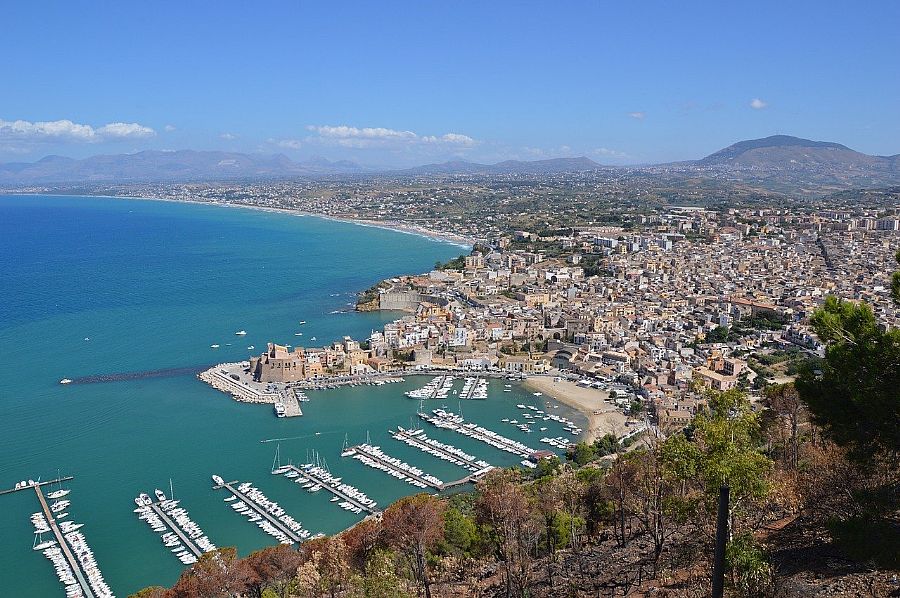Trapani

Stretching out below Monte Erice in the northwest of Sicily, Trapani provides a variety of attractions and allures that will satisfy every taste. It is 1.5 hours from Palermo, and just 45 minutes from Marsala, its port harbors fishing boats and the ferries that travel to the nearby volcanic Egadi islands as well as to Pantelleria, Sardinia and France. It has a regional airport and access to the northern and southern coasts from the west of Sicily. There are lovely beaches, a nice waterfront walkway along the ancient walls, and plenty of sights to enthrall you, but plenty of opportunity to relax and enjoy the sea, a good meal, and a drink on the piazza. Drink in Sicily's ambiance!
Originally settled by the Elymian Sicilian tribe, it developed as a Greek colony, which gave it the name Drepanon, meaning "sickle" perhaps for its crescent-shaped harbour, or maybe for sickles that harvested, as it was an agricultural center for Erice. The ancient revered god was Saturn, whose statue stands in Piazza Sant'Agostino. The Phoenicians came and built up the port, then the Carthaginians conquered in 260 BC, but ceded to Rome in 241 during the First Punic War. It underwent the "usual" series of invaders and rulers through the centuries - the Vandals, Byzantines, Arabs, Normans, Aragons, Angevins, and Bourbons. It enjoyed commercial trade agreements with "the big 4" -Genoa, Amalfi, Pisa, and Venezia, who had a consular presence in Trapani. It was heavily bombed during WWII, and the rebuilding sprawled the city out in all directions, so today it presents an old town along with a thriving new city beyond.
Trapani was -and still is- known for its fishing fleet. In times past, like much of this part of the coast, tuna fishing was an important trade, and there were tonnare facilities at the quay to process and can the incoming fish. Those are gone, but the buildings have been put to other uses in many places; in the case of Trapani, the tonnara was the oldest one of this part of Sicily, though it is now in ruins. The other notable trade was (and is) salt. You can visit the salt pans and take a fascinating trip to how salt is produced and harvested, and the fauna, like pink flamingoes, that make their home amidst the wetlands. The Saline di Trapani is a functioning producer, still following the ancient methods, and also a WWF preserve. There is also a salt museum here. Other products of the area include marble and Marsala wine.
Around town, there are a dozen churches, mostly adorned in baroque embellishments, so seek them out. Of course, the cathedral is the best known, but the church of Purgatorio is something special to see, with its sculptural masterpieces of the Mysteries, and paintings. The Holy Week procession starts here, a major event here in Trapani, as in much of Sicily. Also, don't miss the church of the Madonna of Trapani, officially known as the Basilica di Maria Santissima Annunziata. It houses the unique life-size marble sculpture of the Madonna that weighs 12 tons.The attached convent has been turned into the Pepoli Museum, an extraordinary repository of archeological and artistic gems. There are several museums, including an art gallery, the interesting civic museum at the lovely Torre Ligny out on the harbor, and the contemporary Museum of Optical Illusions.
There are dozens of palazzi, but the Palazzo Cavaretta is a gorgeous architectural jewel, now the town hall, so take a look. Another unusual building is the Palazzo Giudecca, in the via Giudecca, the old Jewish quarter. Built by a banking family, it was also the seat of a school for Talmudic studies until the Spanish rulers expelled the Jewish population. The palazzo was taken over by Ciambara family, who added the unusual stone diamond studs to the exterior. Look carefully for it, in the narrow street it is easy to miss. The Giudecca is the most characterist quarter in Trapani. There are three castles - the Castello della Colombaia at the very point of the harbor; the Castello di Terra, now part of the police headquarters; and Castello di Venere on the hill, the ruins of a 12th century Norman fortress built over Roman temple remains. It offers stunning views from there! Then there is the Bastione di Sant'Anna, a bulwark in the protective walls to guard against incursions, and the walls themselves, along which is a kilometer-long seafront walkway. The Torre dell'Orologio in the heart of the city of one of the oldest public clocks in Europe. The Villa Margherita is a public park, and a beautiful one. The Piazzetta del Tramonto is where to go to see spectacular sunsets.
Don't miss the tramway to Erice! The islands of Mozia and Isola Grande nearby are a fun outing, or any boat ride along the coast. Take a ferry to the Egadi islands for a day (or a private excursion), and of course taste some Marsala wine. The foods here focus on fresh fish, but also the area's vastedda cheese, black bread, couscous, and eggplant (aubergine) caponata.
Have you seen our self-catering apartments in Trapani?

 Amalfi Coast
Amalfi Coast Sorrento Coast
Sorrento Coast Tuscany
Tuscany Cilento National Park
Cilento National Park Lake Como
Lake Como Rome and Latium
Rome and Latium Umbria
Umbria Capri and Ischia
Capri and Ischia Venice
Venice Puglia (Apulia)
Puglia (Apulia) Liguria
Liguria Sicily
Sicily Lake Maggiore
Lake Maggiore Lombardy
Lombardy Sardinia
Sardinia Lake Garda
Lake Garda Abruzzo and Marche
Abruzzo and Marche Calabria
Calabria

